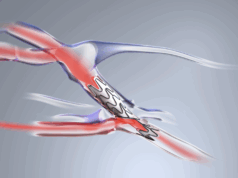
The publication in The New England Journal of Medicine (NEJM) of new research on haemodiafiltration comes following a series of inconclusive prior studies. Lead author Peter J Blankestijn (University Medical Center Utrecht, Utrecht, The Netherlands) and colleagues note that previous trials and study-level meta-analyses have not resolved the “uncertainty” around the therapy’s ability to provide better outcomes for end-stage kidney disease (ESKD) patients, despite differences in practice across continents. Their pragmatic, open-label, randomised, controlled trial (RCT) now offers further clarity on haemodiafiltrations survival benefit compared with conventional haemodialysis.
In four previous RCTs comparing the two treatments, only one—that of Francisco Maduell (University of Barcelona, Barcelona, Spain) et al in the Journal of the American Society of Nephrology (JASN) in 2013—found a statistically significant survival advantage for haemodiafiltration, Blankestijn et al note. These trials also saw the raising of “concerns about attrition” by “observers in the scientific and nephrology communities”, the authors state.
With the need for more data in mind, the study authors designed the CONVINCE trial, in which 1,360 patients underwent randomisation at 61 centres across eight European countries. Of these, 683 patients were assigned to a group receiving high-dose haemodiafiltration while 677 received high-flux haemodialysis.
All patients were aged ≥18 years and had a kidney failure diagnosis, and were candidates for high-dose haemodiafiltration, meaning “a convection volume of ≥23l in postdilution mode per session”. Among the exclusion criteria were “severe nonadherence” to dialysis and prescriptions as well as a life expectancy of less than three months, previous haemodiafiltration less than 90 days before screening and expectation of kidney transplant within six months of screening.
The trial’s primary outcome was identified as all-cause mortality, while secondary outcomes included cause-specific mortality, composite fatal and nonfatal cardiovascular events, kidney transplantation and recurrent hospitalisation from any cause. The authors used Cox proportional hazard models for the estimation of hazard ratios, and they describe patient demographic characteristics as “well-balanced at baseline”.
On the primary outcome, all-cause death occurred in 118 (17.3%) of those in the haemodiafiltration group (7.13 events per 100 patient-years) and 148 (21.9%) in the haemodialysis group (9.19 events per 100 patient-years; hazard ratio [HR] 0.77; 95% confidence interval [CI], 0.65–0.93; p=0.005). Blankestijn et al detail also that 68 (25.6%) of the 266 deaths were attributed to cardiovascular disease, 26 (9.8%) to COVID-19, and 56 (21.1%) to other infections.
A history of cardiovascular events was associated with similar rates of mortality in both groups, but for those without this history the risk of death was lower in the haemodiafiltration group (HR 0.58; 95% CI, 0.42–0.79). Similarly, those in the haemodiafiltration group experienced a lower mortality risk if they had no history of diabetes milletus (HR 0.65; 95% CI, 0.48–0.87).
On the secondary outcomes, outcomes were similar for the two groups apart from on infection-related death. On this measure, which included deaths related to COVID-19, the haemodiafiltration group were again at lower risk (HR 0.69; 95% CI, 0.49–0.96).
“Our trial differs from previous studies in that we enrolled patients who were likely candidates for high-dose haemodiafiltration nearly all the time,” Blankestijn et al explain. “We did not identify an association between failure to achieve the high-dose target and any particular patient characteristic or vascular access type. Thus, our trial results support the evidence that high-dose haemodiafiltration can result in a clinically important survival benefit.” The randomised, controlled nature of the study also means that it avoids “confounding according to indication”, the authors argue.
On the question of their findings’ applicability in the clinical setting, they suggest that their trial design may have yielded a population healthier than the average dialysis population in Europe and the USA, and they suggest that the absolute survival advantage within the haemodiafiltration group “may have varied between individual patients”.
Despite these limitations, the authors conclude that, when looked at alongside other trials and large observational studies, their results “indicate that the safety of haemodiafiltration was acceptable, provided that hygienic and microbiologic rules are fully respected.”
Do the findings CONVINCE?

The trial is said to be an effort to be an “end of discussion” RCT in an editorial published in Nephrology Dialysis Transplantation by the EuDial Working Group of the European Renal Association (ERA), the writing of which was led by Rukshana Shroff (Great Ormond Street Hospital and Institute of Child Health, London, UK). Despite stating that its authors “must be congratulated on performing a rigorous, large-scale trial during the COVID-19 pandemic, it identifies the “major limitation” with CONVINCE that patients “were selected from within the populations of the participating centre”.
The working group note also that “the characteristics of the total potentially available study population was not collected for logistical and organisational reasons”, and they argue that this “preliminary selection of patients” explains the high rates of both recruitment and arteriovenous fistulas (AVFs), as well as the low dropout rate.
“Investigators may have selected somewhat younger patients who were less frail and had fewer comorbidities,” the editorial suggests, “so that they could achieve the target convection volume. Thus, the CONVINCE population is not truly representative of the ‘usual’ population of adults receiving in-centre dialysis in Europe.”
The editorial also states that significantly lower mortality was only found for patients with AVFs rather than grafts or catheters “despite well-matched groups”. Its authors also say that, when outcomes are stratified by convection volume, it could be the case that lower convection volumes “may also achieve beneficial effects, or that there may be a ceiling effect beyond which no further benefit is seen”.
Speaking to Renal Interventions on the study and the editorial, EuDial Working Group chair Carlo Basile (Miulli General Hospital, Acquaviva delle Fonti, Italy) said: “Currently, the uptake of haemodiafiltration in clinical practice is highly variable, and it is not available even in many high-income countries. In addition to monetary costs, the sustainability and environmental burden of dialysis therapy is already substantial.”
He also highlighted the environmental impact of shifting to haemodiafiltration, with sustainability already a developing focus in haemodialysis: “The widespread adoption of online haemodiafiltration would require considerable improvements to infrastructure in some settings, in particular the provision of ‘ultrapure’ water. The production of such ultrapure water has an important climate impact: the production of an extra 23 litres of ultrapure water per dialysis session (required for some haemodiafiltration machines) would require 66 litres of water per session or 10,300 extra litres of water per patient per year (a 17% increase).
Basile made the case that improved personalisation of dialysis treatment, based on the benefits of haemodiafiltration shown in “select subgroups” in CONVINCE would “offer a compromise between improving survival and reducing the climate impact of dialysis”.
CONVINCE remains “a milestone in dialysis research”, Basile stated. Despite drawbacks, he and the working group conclude, it is the “first convincing evidence” for the survival advantages of haemodiafiltration.











